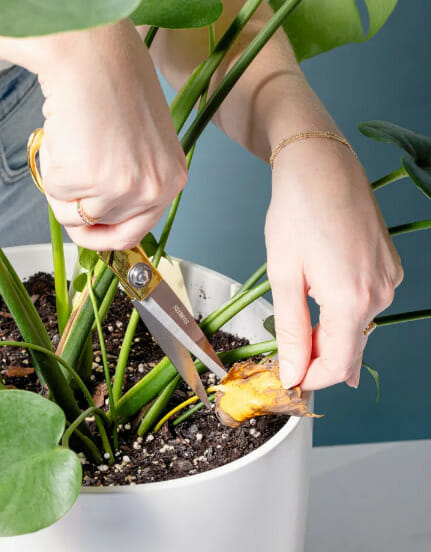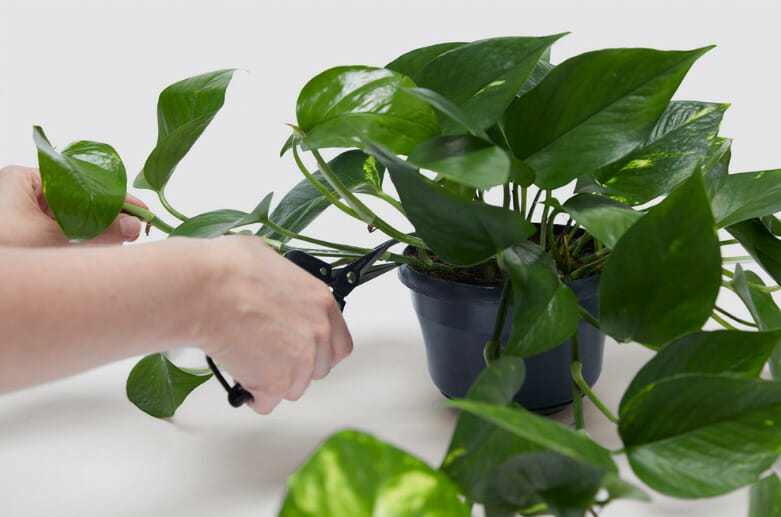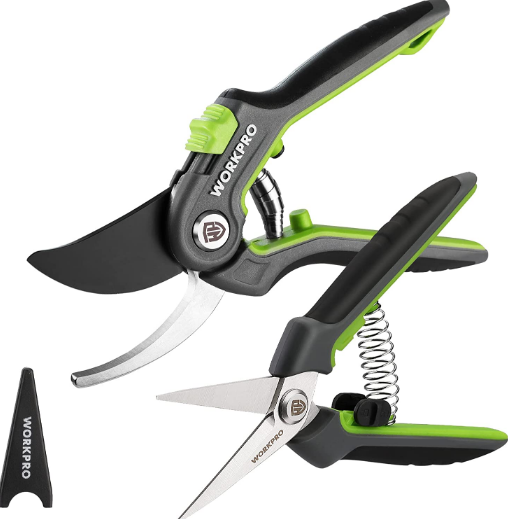Houseplants need extra care if you want them to stay fresh and green. If you have an indoor garden, your plants need a little shaping to look attractive and encourage new growth. The easiest and most reliable way to achieve this is to prune them once in a while. Pruning has a lot of benefits for plants because removing dead foliage prevents pests and diseases. Moreover, It doesn’t allow indoor plants to grow uncontrollably and take up all the space. If you are new to plants, this article is a perfect guide on how to prune houseplants. So let’s start.

1. What is Pruning?
Pruning is a simple technique to cut overgrown leaves and stems from your plants with scissors or other gardening tools. Pruning helps your houseplants look neat and clean, and as a result, they grow healthier and sharper. Moreover, pruning is the cutting of dead foliage from houseplants, so it doesn’t interfere with their growth. You can also prune your houseplants if you think they have grown more than their capacity, and cutting off their pieces can help maintain their original size.
2. Importance of Pruning Houseplants
People have been pruning their houseplants forever, which is very important for their growth. When you trim outgrown leaves, and your plant gets into good shape, it causes the plant to get healthier and fresher. Pruning or little trimming also helps plants maintain good shape and grow with a beautiful stance.
It’s like trimming your hair because you want to get rid of any rough edges and also want them to grow more. The same criteria stand for pruning houseplants.
2.1. Benefits of Pruning Houseplants
There are endless benefits your plants get when you prune your houseplants. Some of them are mentioned as follows:
- Kills Any Harmful Growth
When you prune your houseplants, any harmful growth of insects and bacteria stops. The reason is that when you prune your plants with a sterilized tool, any organism that can hurt your plants will stop multiplying. Also, ensure your tool is properly sharpened, and you smoothly cut the stems and leaves.
- Makes Your Houseplants Look Decent
Overgrown leaves and stems look dirty and unkempt. So pruning helps you to sharpen your plant’s appearance and makes it look decent. You can cut your plants however you like if it will make them look clean and tidy.
- Encourages Healthy Growth
When you remove all the extra leaves and stems from your houseplants, it encourages their healthy growth. As the plants grow, they become laggy and wild. So by pruning, the plants will have a healthier structural growth.
- Shapes Your Houseplant
When you cut all the extra leaves, you can shape the houseplant in whatever way you want. By cutting the leaves, you will decrease any amount of unruly structure growing onto your plants.

3. How To Prune Houseplants?
Pruning plants is nothing complicated as you only need some specific tools, your time and your attention. You can start off by trimming edges and removing dead leaves and flowers. From there, you can slowly start pruning the branches and stems.
3.1. Material Needed:
- Pruning shears
- Kitchen scissors
- Gardening gloves
- An overgrown plants
3.2. Step-By-Step Guide:
You will be able to prune your houseplants after reading the steps below. Let’s see how you can prune your green babies.
1- Removal of Dead Foliage From Your Plants:
First thing while pruning, remove anything that adds a dead look to your plant.
Step 1: Observe your plant. Look for any yellow or brown leaves. Moreover, also check for dead leaves that have fallen on the soil.
Step 2: Take out your pruning tools and disinfect them with bleach. Once they are clean and ready to work their magic, use a pruning scissor to cut dead leaves and anything extra that gives a scruffy look to your plant. You can also use gardening shears to cut.
Step 3: With your selected tool, trim any dead leaves, branches, or stems that are not showing growth. Ensure you do not cut anything that can stop your plant’s growth. Also, remove dead leaves fallen on the soil by hand.
Step 4: Remove any wilting and discolored flowers from the houseplants.
Step 5: After pruning the plant, fertilize it so it can grow pest free.
Step 6: Lastly, water the plant.


CARE: Make sure you do not overwater it and use fertilizers more than the needed amount as these factors can also cause abnormal growth in your houseplant
2- Cutting Overgrown Stems and Branches
Another aspect of pruning is removing extra stems and branches. By cutting them, your houseplant will get a nice shape.
Step 1: Observe your plant for any uneven growth on one side. If you feel the plant is fuller only on one side, it needs some pruning.
Step 2: Start with cutting the branch that is the longest. Make sure that you cut it at 45 degrees, as this angle will help the branch to grow at a precise rate.
Step 3: After you are done, look for leggy branches and falling off. Cut them at a certain angle too. If you have plants that consist of soft stems like English Ivy, you only have to pinch them to remove anything extra. Pinching them at the nodes or snapping the vine with your fingers will help plants grow into a decent shape.
Step 4: In the end, add fertilizer and water to the plant to show even growth.
Step 5: Put the plant in place with sufficient sunlight and air.

When you cut overgrown stems from the node, you can also propagate the stems by rooting them in water. When the roots appear then, you can transfer the soil to a pot with potting mix.

CARE: Do not cut any nodules or buds, as it will trigger the plant and will not blossom according to your expectations.
Related Article: How to Grow plants From Cuttings in Water? A Beginner’s Guide to Plant Propagation
4. Pruning Houseplants Tips:
Proper pruning requires an understanding of the plant’s growth pattern. Pruning is an important technique that helps in the growth of plants. However, it should be done at the right time for the right plants.
4.1. When to Prune Houseplants?
Indoor plants require less pruning than outdoor plants as they are less affected by seasonal changes. However, they also require pruning every now and then for proper growth and neatness. Light pruning can be done any time of the year. In case you want to do detailed pruning involving the cutting of branches and leaves for reshaping, then late winter and early spring is the best time for that. Because the long daylight hours will help the plant in recovering faster.
4.2. Houseplants that Need Pruning
There are a lot of houseplants that need pruning now and then. Many factors are involved if you need to determine if your plant is good enough for pruning or not. If your plant shows abnormal growth and the leaves and stems are spreading everywhere, they require a little trimming or pruning.
There aren’t any specific plants that always need pruning. If you are taking care of houseplants for long, you will just know when a plant needs you to carry a gardening spear to chop some of its ends. Many flowering plants like spirea, weigela, roses, etc. take a lot of benefit from pruning.
4.3. Houseplants that Don’t Need Pruning
Some plants do not need pruning and if you accidentally do prune them, you are shortening their life span. There are only a few plants that do not need pruning. If you accidentally prune them, there is a high chance that their branches won’t grow back, and as a result, your houseplant will be dead. So, always do full research before pruning the plants because, unknowingly, you can harm them too.
- Succulents
- Snake Plant
- ZZ plant
- Moth orchids
You can do the occasional dead leaves removed from the plants like ZZ plants and succulents. However, it is not recommended to do substantial pruning as it will affect their growth.
5. Cons Of Pruning Houseplants
Pruning is undoubtedly very beneficial to several plants. However, there are some things that one must remember about pruning.
- Some Plants May Not Want It
Some houseplants do not want pruning as it can stop their growth. So it is better to check on the internet or with a professional to know if you should prune your plant or not. Some plants, like orchids, do not need pruning or even trimming. So you have to be cautious with them.
- Can Increase Insects Growth
If you haven’t used a sharpened and sterilized tool while pruning, there is a big chance that your plant can get bacteria or insects. Leaving branches and stems untrimmed will have negative effects, but your plant can also die if it is not done properly.
- Pruning At A Wrong Time
If you prune your plants at the wrong time, this can harm them too. If your houseplant tends to grow flowers, you have to prune it at the start of spring, and if you have flowerless plants, it is good to prune them at the start of winter. Pruning the plants when they do not want it can harm their growth and well-being.
Recommended Products

Garden Pruner and a Regular Clipper
- Includes a regular trimmer and a gardening pruner
- Highly sharp blades
- Premium design with spring that reduces hand fatigue while cutting
- Garden pruner has a safety lock

Garden Tools Set with Pruning Shears
- A professional sharp and reliable harvesting shears,
- A repotting mat made of Eco-friendly canvas fabric
- Plant transplanting tools
- Cleaning brush
- Tools are lightweight and easy to maneuver
Sum Up:
Pruning isn’t a time taking or complex task. It takes only some minutes of your time but promises healthy growth of your houseplant. Make sure you trim your plants at least twice a year so they can grow up to their potential and give you some greenery to breathe in.
If you enjoyed this article, visit our website for more articles.
